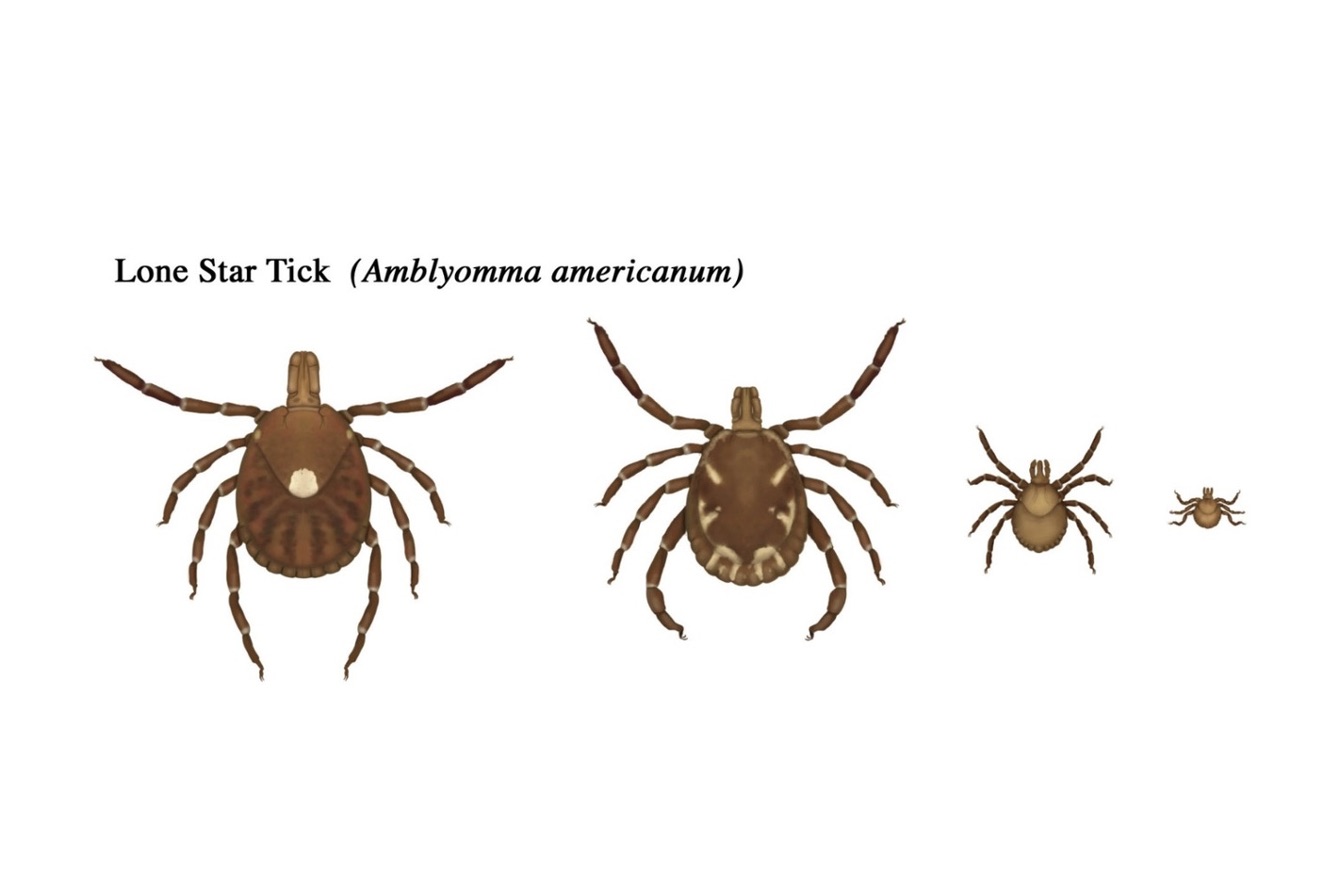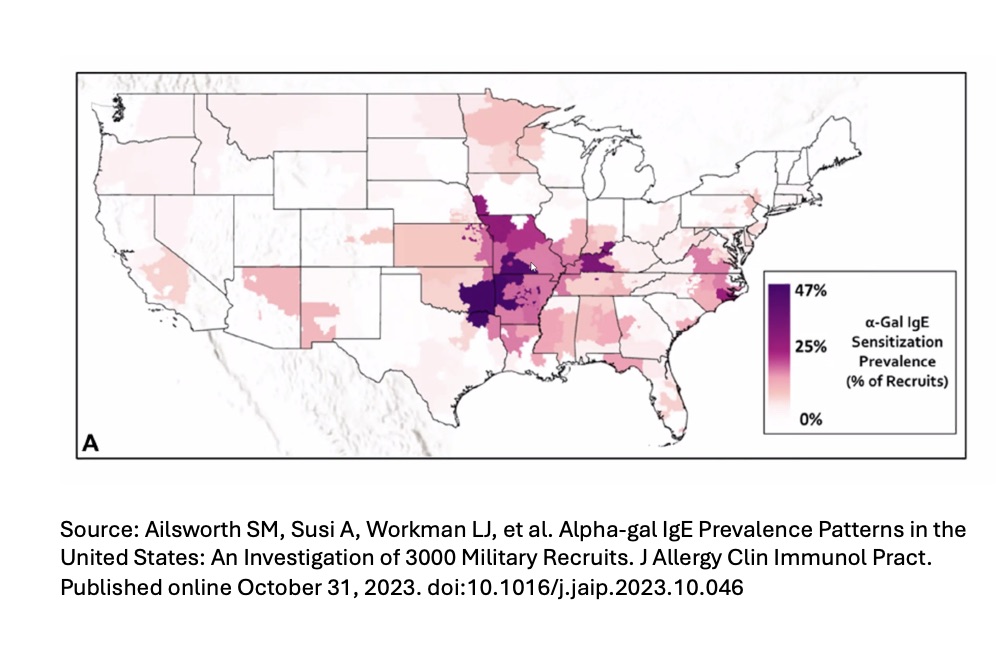Area of focus #5
Prevention
Additional areas of focus
Drugs and medical devices
Food
Education
Research and epidemiology
Goal
Reduce the incidence of alpha-gal syndrome
Priority #1
Address white-tailed deer overpopulation

Challenge
- White-tailed deer are the keystone host of lone star ticks (Amblyomma americanum), which feed on them at all stages of development.35
- White-tailed deer support enormous numbers of lone star ticks. A single ear of a white-tailed deer can be infested by more than 2,500 lone star ticks.35,36,37
- The correlation between the number of white-tailed deer and the number of lone star ticks has been confirmed by both mathematical models and by deer exclusion studies.35
- White-tailed deer are also a primary vehicle of transport for lone star ticks.35
- In the 1930s, there were an estimated 300,000 white-tailed deer population in the U.S. Today, there are 30 million.49
- There is an overabundance of white-tailed deer, particularly in urban and suburban settings where densities can reach 78 deer/km2. This is due to:
- Evidence for integrated tick management or individual strategies to result in reduced human tick bites or human tick-borne illness is lacking.125
- Addressing white-tailed deer populations has been identified as the best hope of stemming tick-borne conditions associated with lone star ticks. 35
- Primary impediments to addressing white-tailed deer overpopulation include:
- Social perceptions regarding wildlife
- Wildlife management practices that have led to an overabundance of deer.43
Opportunities
- Require that disease risk, in addition to carrying capacity, be incorporated into federal and state analyses of optimal deer density.
- Revise wildlife management strategies to address deer overpopulation in areas with a high prevalence of AGS.
Alignment with National public health strategies and expert recommendation
- In the paper “Ecological Havoc, the Rise of White-Tailed Deer, and the Emergence of Amblyomma americanum-Associated Zoonoses in the United States,” Paddock and Yabsley identified control and management of white-tailed deer populations as the best hope for stemming health conditions associated with lone star ticks.35
- The National Public Health Strategy to Prevent and Control Vector-Borne Diseases in People, which includes AGS as a vector-borne condition, has identified a need to:
- Prioritize, develop, evaluate, and improve tools, methods, and guidance to prevent and control vector-borne diseases; 59
- Increase flexibility and coordination in the regulatory processes for novel vector control; 59
- Develop and evaluate public health communication tools, messages, and approaches for encouraging public acceptance of prevention and control guidance.59
The role played by white-tailed deer in the recognition of multiple zoonoses transmitted by A. americanum can be linked to several sources of data that implicate deer as the keystone host for lone star tick populations and as an important natural reservoir for the pathogens that cause these diseases.
Intelligent control and management practices of white-tailed deer populations offer the best hope of stemming further influx of these zoonoses into human populations.
Priority #2:
Accelerate the development, improvement, and evaluation of tick control and tick bite prevention tools and strategies effective against lone star ticks

Challenge
- Lone star ticks are associated with the overwhelming majority of AGS cases in the U.S., in addition to other serious and sometimes fatal tick-borne diseases, including ehrlichiosis, rickettsial disease, STARI, and tularemia.7,8,50,51,52,53
- Lone star ticks are the most frequent tick found attached to humans in the eastern United States, accounting for over 95% tick encounters in areas most affected by AGS.38
- The effectiveness of tick control and prevention strategies and tools differ by species.41
- To date, research on tick bite prevention in the U.S. has focused primarily on black-legged ticks.41,43
- Differences between black-legged ticks and lone star ticks that can influence the effectiveness of control and prevention strategies include: phenology of both ticks and hosts, geographic distribution, tolerance for desiccation, mobility, questing behavior, resistance to acaricides, and other biological, ecological, and behavioral factors.35,38,39,41
- Larval tick bites are disproportionately associated with the onset of AGS.
- Tick control and tick bite prevention strategies specific to lone star ticks, including larval ticks, are needed.41,43 These include strategies for personal, yard, and community-level protection.
- Development and optimization of tools and protocols for removing embedded larval lone star ticks, with an emphasis on reducing the likelihood of subsequent development of AGS, are needed.
- Stronger incentives for developing, testing, and registering new tick control technologies for use against lone star ticks are needed.43
Opportunities
- Secure federal funding for the development, improvement, and evaluation of tick bite prevention tools and strategies effective specifically against lone star ticks, including lone star tick larvae.
- Secure federal funding for the development, improvement, and evaluation tools and strategies for the removal of lone star ticks (including larvae), with an emphasis on minimizing the subsequent development of AGS.
- Increase flexibility and coordination in the regulatory processes to expedite novel tick control specifically targeting lone star ticks.
Alignment with National public health strategies and expert recommendation
- The National Public Health Strategy to Prevent and Control Vector-Borne Diseases in People, which includes AGS as a vector-borne condition, identifies a need to:
- The Alpha-Gal Syndrome Subcommittee Report to the Tick-Borne Disease Working Group identified a need for:
- Funding for research on chemical repellents for personal protection against the lone star tick.131
Compared with BL ticks, LS ticks lay more eggs per female (~5000 vs. 3000), have better nymphal survival, are more attracted to CO2 emitted by hosts, move more quickly, and travel greater distances when questing.
These features make LS ticks much more difficult to avoid and manage than BL ticks.
Many of the best-known tick control methodologies were developed to control blacklegged ticks and are not effective in controlling lone star ticks.
The widest diversity and most current tools for tick control have been developed for I. scapularis, with less recent research on control methods for A. americanum and especially for D. variabilis.
Priority #3
Ensure that states, tribes, and territories disproportionately impacted by AGS have sufficient support and technical assistance to implement tick bite prevention programs

Challenge
- AGS cases are concentrated in high-prevalence areas.8,18
- In high-prevalence areas, AGS makes up the bulk of the tick-borne disease burden.* For example, in Virginia, a state with a high incidence of both AGS and Lyme disease:
- The preponderance of high-prevalence states and tribal lands lack the resources of northern states where Lyme disease is the dominant tick-borne disease.8,18,31,32,34
* CDC and state health department data
Opportunity
- Ensure an equity-centered approach to federal funding and technical assistance for tick bite prevention and control, inclusive of lower-income jurisdictions that are disproportionately affected by AGS.
Alignment with National public health strategies and expert recommendation
- The 2024 National Public Health Strategy to Prevent and Control Vector-Borne Diseases (VBD) in People, which includes AGS as a vector-borne condition, has identified a need to:
- Use an equity-centered approach to prevent and control VBDs and eliminate health inequities. 59
- Advance equity for communities that are underserved and at disproportionate risk of exposure to vector-borne conditions. 59
- Embed health-equity principles into the design, implementation, and evaluation of research, data, surveillance, intervention, and evaluation strategies for prevention and control of vector-borne conditions.59
- Facilitate partnerships across sectors, including disproportionately affected communities, to develop tools and reduce health disparities.59
If testing trends continue, and the geographic range of the lone star tick continues to expand, the number of AGS cases in the United States is predicted to increase during the coming years, presenting a critical need for synergistic public health activities including community education targeting tick bite prevention to reduce the risk for acquiring AGS.
The results of the current study can aid in initiating national surveillance efforts for this emerging allergic condition and for geographically targeting high-risk populations for public health outreach and HCP education.
Priority #4
Understand and address the impact of climate change on lone star tick populations and alpha-gal syndrome

Challenge
- Climate change drives both increases in local tick populations and their expansion into previously unoccupied areas.12,61 This is a result of:
- In addition, rising temperatures expand the period of the year when ticks are active.61
- As lone star tick populations expand, so does alpha-gal syndrome.12,61
Opportunities
- Secure federal funding to study and address the impacts of changing climate on lone star tick populations and AGS
Alignment with National public health strategies and expert recommendation
- The 2024 National Public Health Strategy to Prevent and Control Vector-Borne Diseases in People, which included AGS as a vector-borne condition, identified a need to understand and address the impacts of a changing climate on vector-borne conditions.59
- The Office of Climate Change and Health Equity highlighted alpha-gal syndrome as a growing, climate-related health hazard in the Nov 2023 Climate and Health Outlook report.61
Considering the medical significance of lone star ticks, their broad host range, and the relative abundances at which they are at times found, the present-day distributional pattern estimated in this study points to a major public health problem. That is, this distributional estimate exceeds the mapped suitable area presented previously by CDC.
The future potential distribution of the lone star ticks under high and low emissions scenarios considered here indicate marked expansions of lone star tick range, and particularly northward expansion of suitable areas for this tick is clearly evident.
